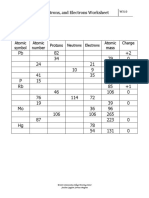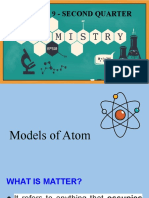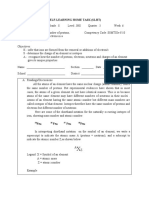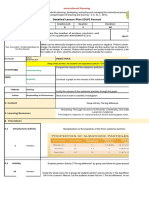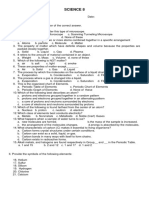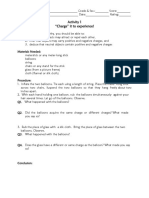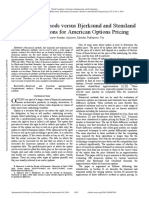Name: ___________________________________ Score: _____
Grade Level/Section: ____________________
Science 8 Quarter 3 - Module 5: Atomic Structure (The
Subatomic Particles)
What I Need to Know
This module was designed and written in a way that suits your
understanding and needs. In this module, you are expected to determine the
number of protons, neutrons, and electrons in a particular atom (S8MT-
IIIe-f-10). The activities included in the module will help you learn about the
particles that comprise an atom.
After doing the activities of this module, you are expected to:
⮚ Identify the subatomic particles of an atom.
⮚ Describe the subatomic particles of an atom.
What's In
In the previous module, you learned that changes in the arrangement
and motion of particles change the physical state of matter. Let's try to recall
these physical changes by doing the activity below.
Activity1: PHASEcal Change!
Direction: Identify the phase change involved in each item below. Write your
answer on the space provided.
1. The phase change from 2. The phase change from
solid to liquid is called liquid to gas is called
_________. _________.
3. The phase change from 4. The phase change from
liquid to solid is called gas to liquid is called
_________.
_________.
What's New
Matter is made up of atoms that are too small to be seen
with the unaided eye or even with the use of the ordinary
1
� light microscope. When the ancient Greek philosophers conceived the idea
of the atom, they thought that the atom is indivisible and that it has no
parts. However, scientists have proven that the atom is composed of even
smaller particles.
To give you an overview of the atomic structure, try to answer the next activity.
Activity 2: Getting to Know Each Other!
A. Label the parts of the atom. Choose your answer from the box.
Proton Electron Neutron Nucleus
B. Identify what part of the atom is described.
1. The sub-atomic particle with no electrical charge is called __________.
2. The sub-atomic particle with a positive charge is called _____________.
3. The sub-atomic particle with a negative charge is called ____________.
4. The small dense region in the atom where protons and neutrons are found is
called ____________.
What is It
Scientists have collected evidence that atoms are composed of three types of
particles, namely the protons, electrons, and neutrons. These
components of the atom are collectively referred to as subatomic
particles. The nucleus of the atom contains protons and neutrons. The
outer regions of the atom holds the electrons.
Figure1: Structure of an Atom
Source: courses.lumenlearning.com
2
�Atoms are electrical in nature. They contain particles with positive and
negative charges. The proton carries a positive charge (+1). The electron
carries a negative charge (-1). Atoms in their most stable state are neutral
with an equal number of protons and electrons. For example, if an atom
has 5 electrons, then it also has 5 protons. The other particle in an atom
is neutron, which does not carry any charge or is neutral.
The properties of the three subatomic particles are summarized in the table
below.
Table1. Some properties of the three main subatomic particles
Subatomic Location in the
Particles Charge Mass (grams) Atom
(symbol)
Electron (e-) -1 9.109x10-28 Outside nucleus
+ 24
Proton (p ) +1 1.672x10- Nucleus
0 24
Neutron (n ) 0 1.675x10- Nucleus
Protons and neutrons have approximately the same masses.
Both subatomic particles are found in the nucleus. On the other hand,
electrons are found outside the nucleus and are the smallest
subatomic particles. The number of protons determines the atom's
identity, and the number of electrons determines its electrical charge.
The atomic number tells the number of protons in one atom of an
element. It also tells the number of electrons in a neutral atom of the
element. The mass number is the sum of the total number of protons
and neutrons in the nucleus of the atom. Electrons do not contribute
much to an element's overall atomic mass because they are considered
nearly massless in comparison to the masses of protons and neutrons.
The number of neutrons can vary to produce isotopes, which
are atoms of the same element having the same atomic number but
different mass numbers.
Table 2. The Isotopes of Carbon
Number of Number of Number of
Element protons neutrons electrons
Carbon-12 6 6 6
Carbon-14 6 8 6
The number of electrons can also be different in atoms of the same
element, thus producing ions (charged atoms). For instance, Iron (Fe) can
exist in its neutral state or in the +2 and +3 ionic states.
3
� What I Have Learned
Activity 4: Fill the Space!
Read each statement carefully. Select the correct term from the word bank
and write your answer on the space provided after the number.
WORD BANK
atomic number mass number
identity
electrical charge electrons
nucleus
protons same
The number of protons in an atom of an element determines the atom’s
1.______________ and the number of electrons determines its 2._____________.
The atomic number tells you the number of 3._____________ in an atom of an
element. It also tells you the number of 4. ____________ in a neutral atom of
the element. The 5.____________ gives the identity of an element as well as its
location on the Periodic Table. No two different elements will have the
6.____________ atomic number. The 7.___________ of an atom for an element
is the sum of the total number of protons and neutrons in the 8.____________
of the atom.
Assessment
Directions: Read and analyze each item
carefully. Select the correct answer from the choices given by writing the
corresponding letter on the space provided before each number.
______1. Which of the following are the three subatomic particles that make up an
atom?
A. Proton, neutron, and
isotope B. Proton, isotope,
and electron
C. Proton, electron, and negative
D. Proton, neutron, and electron
4
�______2. Which of the following are the subatomic particles found in the nucleus
of an atom?
A. Protons only
B. Proton and neutron
C. Electron and neutron
D. Electron and proton
______3. Which subatomic particles contribute the most to the mass of an atom?
A. Protons, neutrons and electrons
B. Protons only
C. Protons and electrons
D. Protons and neutrons
______4. What do you call the negatively charged particles that orbit around the
nucleus of an atom?
A. Neutrons
B. Electrons
C. Protons
D. Ions
For no. 5-6, refer to the illustration below.
______5. Based on the illustration, which letter represents the protons?
A. B
B. C
C. A
D. A and B
______6. What subatomic particle is represented by the letter C in the figure (No. 5)?
A. Proton
B. Electron
C. Neutron
D. Nucleus
______7. Describe the relative mass and electrical charge of a neutron?
A. It has a mass of 1 and charge of -1
B. It has a mass of 0 and charge of +1
C. It has a mass of 1 and charge of 0
D. It has a mass of -1 and charge of +1
______8. Which of the following statements is true about the mass of protons and
electrons?
A. Protons and electrons have the same mass.
5
� B. Protons are lighter than electrons.
C. Protons are heavier than electrons.
D. Proton and electron masses cannot be determined.
______9. Which of the following statements describes the mass number of an
atom? A. It is the number of protons in the element's atomic nucleus.
B. It is the sum of the total number of protons and neutrons in an element's
atomic nucleus.
C. It is the average mass of electrons
D. It is the total number of protons and electrons.
______10. Four atoms have the number of protons and neutrons given below.
Which two atoms are isotopes of the same element?
W: 8 protons and 8 neutrons
X: 8 protons and 10 neutrons
Y: 10 protons and 8 neutrons
Z: 9 protons and 10 neutrons
A. X and Y
B. W and X
C. X and Z
D. W and Y
Additional Activities
Word Solver
Complete the puzzle below. Clues are given to guide you. (Leave a space to separate
words)
6
�Horizontal
2. A negatively charged subatomic particle.
6. A neutral particle of the atom.
7. The weighted average of all the isotopes of an element
Vertical
1. It tells the number of protons in the atom of an element
3. Atoms of the same element have the same atomic number but different mass
numbers due to the different numbers of neutrons in their nuclei.
4. A positively charged subatomic particle
5. The small dense region in the atom where protons and neutrons are found Concept
Map
Complete the concept map on “changes” in an atom and the resulting particle
that is formed as a result of the change. Choose your answer from the box.
A new element Isotope
Nucleus
Ion Molecule
7
� The change in the
number of protons
will result to the 4.
ATOM formation of ______
The change in the
number of neutrons
in the atomic
nucleus will result to
The change in the the formation of
number of electrons
in an atom will
result to the
formation of 3.
The chemical
combinations of
______
atoms will result
to the formation of
1.
______
2.
______
Answer Key Gr8Q3 Module 5
8
�What’s More
Activity 3
1. Electron
2. Neutron
3. Proton and neutron
4. Proton and neutron
5. No
9
� Electrons are very light and
very small particles
10




